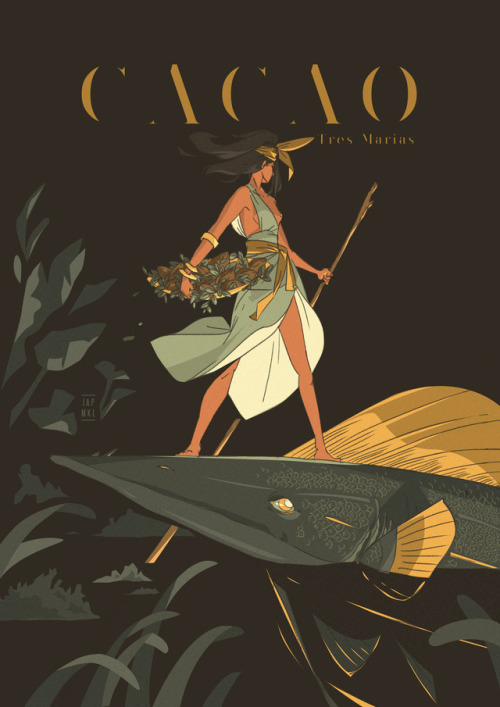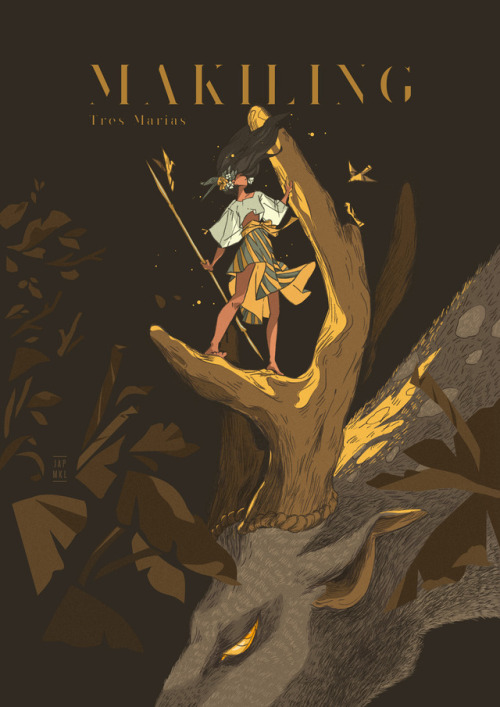
Mutifandom (Mouthwashing Brainrot) || Fanart & OCs if I'm not lazy lol
80 posts
Latest Posts by 120delyn - Page 3

My Folktober drawing for today is the Philippine diwata, or faery, Maria Makiling. Historically referred to as Dayang Masalanta, Maria Makiling is the guardian spirit of Mt. Makiling. She is regarded as protector of the mountain and its people, and is called upon to stop earthquakes, storms, and flooding.

Maria Cacao, Maria Sinukuan and Maria Makiling

Sa Kalaliman ng Kagubatan
Keep reading
![PHILIPPINE MYTHOLOGY MEME | [1/4 LEGENDS + 1/3 LOCATION] THE LEGEND OF MARIA MAKILING + HER MOUNTAIN](https://64.media.tumblr.com/ae505afa5cf920f9e2f1a4bbcf210e44/tumblr_ndm0r4fsJX1sn5v3to2_500.png)
![PHILIPPINE MYTHOLOGY MEME | [1/4 LEGENDS + 1/3 LOCATION] THE LEGEND OF MARIA MAKILING + HER MOUNTAIN](https://64.media.tumblr.com/3e2ae99d01be6a3d732ee69b809d7a14/tumblr_ndm0r4fsJX1sn5v3to1_500.png)
PHILIPPINE MYTHOLOGY MEME | [1/4 LEGENDS + 1/3 LOCATION] THE LEGEND OF MARIA MAKILING + HER MOUNTAIN DOMAIN
Maria Makiling, sometimes spelled Mariang Makiling, in Philippine Mythology, is a diwata or lambana (fairy or forest nymph) associated with Mount Makiling in Laguna, Philippines. She is the most widely known diwata in Philippine Mythology. Maria Makiling is the guardian spirit of the mountain, responsible for protecting its bounty and thus, is also a benefactor for the townspeople who depend on the mountain’s resources. In addition to being a guardian of the mountain, some legends also identify Laguna de Bay - and the fish caught from it - as part of her domain.
It is often said that Mount Makiling resembles the profile of a woman, said to be Maria herself. This phenomenon is described as true from several different perspectives, so there is no single location associated with this claim. The mountain’s various peaks are said to be Maria’s face and two breasts, respectively, and her hair cascades downwards a gentle slope away from her body.
The most common story is that of Maria turning ginger into gold to help one villager or the other. In these stories, Maria is said to live in a place known to the villagers, and interacts with them regularly. The villager in question is often either a mother seeking a cure for her ill child, or a husband seeking a cure for his wife. The wise Maria recognizes the symptoms as signs not of disease, but of hunger brought about by extreme poverty. She gives the villager some ginger, which, by the time the villager gets home, has magically turned to gold In versions where the villager is going home to his wife, he unwisely throws some of the ginger away because it had become too heavy to carry. In some versions, the villagers love her all the more for her act of kindness. In most, however, greedy villagers break into Maria’s garden to see if her other plants were really gold. Distressed by the villager’s greed, Maria runs away up the mountain, her pristine white clothing soon becoming indistinguishable from the white clouds that play amongst the trees on the upper parts of the mountains.
![AESTHETIC MEME [1/4] Philippine Mythology/Folklore](https://64.media.tumblr.com/8f17936c542c6c66023c6f2562d64f64/tumblr_o8i7769I731rul0a7o1_500.png)
![AESTHETIC MEME [1/4] Philippine Mythology/Folklore](https://64.media.tumblr.com/5a065d975c3987f1a6e4171b37dee50e/tumblr_o8i7769I731rul0a7o2_500.png)
AESTHETIC MEME [1/4] Philippine Mythology/Folklore
┗ The Legend of Maria Makiling: Once upon a time, a diwata lived in a mountain of Laguna. She was called Maria Makiling. She has light olive skin, long shining black hair and twinkling eyes. She was breathtakingly beautiful. Maria was always about helping other people. One time, the children of a farmer got sick. When he went to Maria to seek help, he was given a bilao full of ginger. The farmer sadly went home carrying the bilao of ginger. When he reached his hut, he was greatly surprised: the ginger had turned to gold! Because of Maria’s kindness, the townsfolk had grown to love her.


Maria Makiling is a diwata (forest nymph) that is said to reside in Mount Makiling. She is the guardian spirit of the mountain, responsible for protecting its bounty.
It is often said that Mount Makiling resembles the profile of a woman, said to be Maria herself.
Maria was sought for and wooed by many suitors, three of whom were the Captain Lara, a Spanish soldier; Joselito, a Spanish mestizo studying in Manila; and Juan who was but a common farmer. Despite his lowly status, Juan was chosen by Maria Makiling.
Spurned, Joselito and Captain Lara conspired to frame Juan for setting fire to the cuartel of the Spanish. Juan was shot as the enemy of the Spaniards. Before he died, he cried Maria’s name out loud.
The diwata quickly came down from her mountain while Captain Lara and Joselito fled to Manila in fear of Maria’s wrath. When she learned what happened, she cursed the two, along with all other men who cannot accept failure in love.
Soon, the curse took effect. Joselito suddenly contracted an incurable illness. The revolutionary Filipinos killed Captain Lara.
(x)

made this illustration for my buds over at reinvent mag cool cool cool
this was based off of maria makiling, a popular diwata found in philippine folklore

@femmefatalenet | event thirteen: one year celebration | maria makiling
Guardian of the mountain in Philippine mythology
She is responsible for protecting its bounty and acts as benefactor for the townspeople who depend upon the mountain’s resources.

T E E N A G E G I R L S + M Y T H O L O G Y: Maria Makiling
She climbs to the peak of the highest roof, the tallest tree, scales the biggest pylon, unaffected by vertigo and unafraid of the danger. There is something stoic and grand about her, as if she is carved from ancient stone, standing tall and proud for century after century. The soft curve of her lips pulls up into a smile when they tell her she is their pillar, the perfect support throughout hardship. She protects those who depend on her, offering them help in times of need.

maria makiling. one of the more interesting figures of philippine mythology that i found when doing research. all of it is pretty interesting, though!! :)
time: ~3 h 30 mins






Mariang Makiling, The Mountain Spirit
[Photos Edited by https://twitter.com/romamiina]

Maria Makiling by Lasarasu
Maria Makiling is a forest nymph associated with Mount Makiling in Laguna, Philippines. She is the most widely known figure in Philippine mythology. This artist on Instagram

Nat Lamina 🎨🖌@lasarasu
Maria Makiling, 2023, oil on canvas, 24" × 36".
"Maria Makiling in Philippine mythology is a diwata (fairy) associated with Mount Makiling in Laguna, Philippines. She is the most widely known diwata in Philippine mythology and was venerated in pre-colonial Philippines as a goddess known as Dayang Masalanta who was invoked to stop deluges, storms, and earthquakes."
![[image Described In Captions]](https://64.media.tumblr.com/bc98d4b1b894847c54cea9912e6f7f26/tumblr_nsal80K6JD1qawgpko1_r1_500.png)
![[image Described In Captions]](https://64.media.tumblr.com/fb36eabe52bd1a287ce11f5b11839a60/tumblr_nsal80K6JD1qawgpko2_r1_500.png)
[image described in captions]
Maria Makiling is a diwata or lambana (faerie or forest nymph) in Philippine mythology associated with Mount Makiling, Philippines. She is said to be the benefactor of the townspeople who depend on the mountain, as she is responsible for its bounties. It is said that the mountain resembles the profile of a woman, an image of Maria herself.
She is often depicted as one of three characters: a fierce protector of the forest surrounding the mountains, a provider known to give ginger that turns into gold to poor villagers, and a spurned lover afraid to love a mortal once more. Even today there are still reported sightings of her presence, from lost hikers, disappearances attributed to her presences, and students who go to the university at the foot of the mountain, University of the Philippines in Los Baños.
Translations (Filipino to English):
they are maria makiling
part, n./adj.: this is a part of my love, that I can never wholly receive anything from you - whether it be answers, time, or shelter - and that’s okay. [source of original text]

FILIPINO MYTHOLOGY: TRES MARIAS (Mountain Goddesses/Fairies)
Maria Cacao, Maria Makiling, and Maria Sinukuan are mountain goddesses (or fairies) with their own separate jurisdictions. The most famous of the three, Maria Makiling, is the guardian of Mount Makiling, located in Laguna. The mountain is said to resemble the profile of a woman, perhaps of Maria herself. Maria Cacao watches over Mount Lantoy in Cebu, and it is said that her domain houses the Cacao plants, a useful ingredient in most Filipino chocolate delicacies. Lastly, Maria Sinukuan holds dominion over Mount Arayat in Pampanga. There, she is said to bring forth bountiful harvests from the mountain’s fruit trees.

Maria Makiling Aesthetic
Si Maria ay kaisang-isang anak nina Dayang Makiling at Gat Panahon, na para-parang bathala o engkantado kung sa ngayong pakahulugan. Tanging-tanging mutya ang nabanggit na lakambini sa kanilang tahanan pagka’t siyay'y bugtong na aliw ng kanyang ama’t ina. Siya ang liwanag ng kanilang paningin; siya ang galak ng kanilang puso; anupa’t sa biglang pangungusap, siya ang kayamanang impok ng kanilang buhay. Sa kanilang katandaan, si Maria ang bango at kulay ng mga araw nilang unti-unting nawawalan ng sigla’t lakas.
Alamat ni Maria Makiling [x]


@fyeahmyths two weeks event: day twelve.
asian creature: [philippine] m a r i a m a k i l i n g
in philippines, it is believed that there is a forest nymph who is the guardian spirit of the mountain - and a benefactor of the townspeople who depend upon the mountain’s resources. people claim that the mount makiling in philippines is itself shaped like the spirit - her face and two breasts being discernible in its various peaks.






Filipino Mythology Week → Day 4: Myths/Folk Tales
The “Maria” Diwatas




Tres Marias: The Mountain Diwatafolk of Las Islas
Maria Sinukuan The eldest of the Three Diwata sisters and protector of her domain, Mount Arayat. One of her legend tells that she had a demon suitor who desired her hand. She gave him a test to prove his worth – to build a stone bridge without any support overnight. When the demon has almost accomplished his task, Sinukuan sabotaged the test by telling the rooster to crow early before dawn. The demon gave up, thinking that he failed.
Maria Cacao
The second of the Diwata sisters and protector of the Visayan dark woods where Chocolate Trees grow. It was believed that when the river overflows, Cacao is travelling through the river on a golden barge to personally deliver dark fruits to the river gods.
Maria Makiling The protector of her domain, Mount Makiling and the youngest among the Diwata sisters. She was also the most popular because she was more benevolent and curious of people than her sisters. She once fell in love with a hunter that caused wrath from Sinukuan. Her eldest sister reminded her of their duty as a Diwata and falling in love means leaving their mountain domains vulnerable. After realizing that the mountain needs her more, she appeared to the hunter one night – to break his heart. The unbearable pain in her heart caused her to vanish and never appeared to anyone from then on.